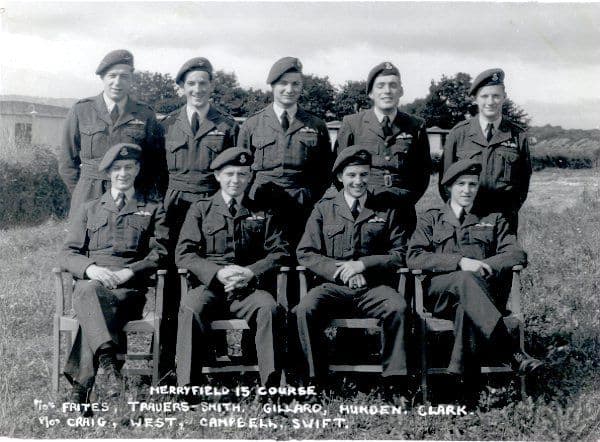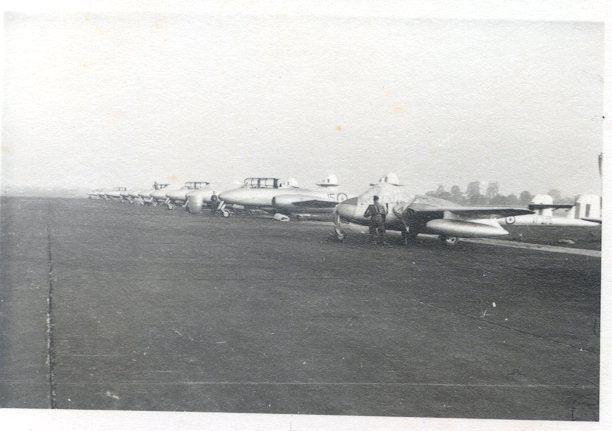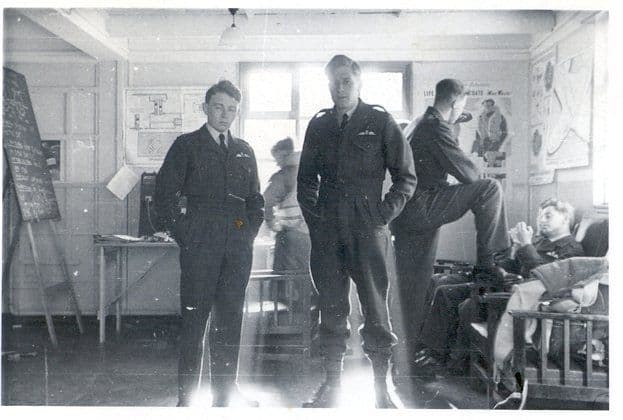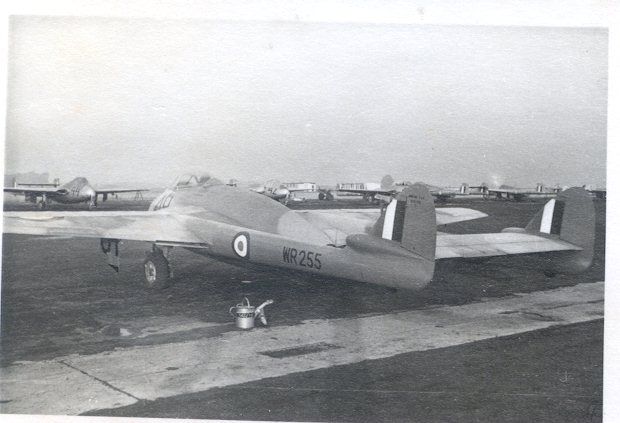
| I was part of the new jet age converting from pistons and joined 208 course Merryfield in Sept 1952. My instructor, F/O Bennett. The Vampire T11 was not yet in service so we flew dual on the Meteor 7 and were then sat in a Vampire 1 or 3 and launched into the sky. Your first solo was your first flight in a Vampire and it could be tricky when you lowered the flaps, the nose would pitch up sharply. It was a rudimentary aircraft and the instrumentation was definately piston era. We lost about one pilot per month in training. My pal Johnny Gillard speared in at Curry Rivel one stormy day and is buried at the local churchyard. |
I had graduated from No.6 Flying Training School at Ternhill in Shropshire in August of 1952 after a total of 208 hours on Prentice and Harvard aircraft.
On September 10th I commenced my jet conversion onto Vampires at Merryfield in Somerset.

At this time, the Vampire trainer the T11 was not in service and the only way to qualify on the Vampire was to get a little experience of jet flying on the Meteor 7 with an instructor and then be shown around the cockpit of the Vampire prior to opening up the throttle and getting airborne. My dual time on the Meteor came to 5 hours in seven sorties.
| Vampire III with drop tanks and Meteors in the background. Merryfield 1952. Note the high tailplanes and square tail fins of the old MK III Vampires. Also note the small intakes on the Meteor VII's. |  |
 | Fred West and Jack Frith in the crew room at Merryfield 1952. These guys are probably still living somewhere. |
Particular emphasis was given to the fact that on the approach to landing, and at a comparatively low speed, putting the flaps down resulted in a movement aft of the center of pressure and the nose would rise and put the novice in peril of a stall. Not very comforting since there was no way to experience this little trick other than by trying it for real. The bale out procedure was almost useless to the point of making it hardly worth the breath. In essence, if you wished to part company with the Vampire you had to be in full control, completely calm and have several thousand feet to spare. There was no ejection seat and the only practical way out if you wished not to be involved with the huge tailplane that spanned the twin booms was to roll her on her back, trim fully forward, release the hood and let go the stick whilst undoing the seat harness. This procedure would hopefully propel you by centrifugal force clear of the tailplane and then in a calm and collected manner you could look down for the "D" ring on the parachute and float serenely to earth. If all went well and you had the good fortune to land close to a pub you could pop in for a quick one before calling base to come and pick you up, it was all quite civilised. I cannot really recall personally that this procedure worked for anyone but I do believe that one or two lucky airmen did make it.
If during aerobatic manoeuvres you had the misfortune to lose an engine ( ie. the light went out) then chances were that you would never relight it. There was a little button on the side of the cockpit that one could press that was, I believe, connected to some kind of high intensity spark, but it was apparently of little use and one was advised to try and keep the aircraft from tailsliding, just to be on the safe side. I never had to use it so I cannot attest to its efficiency.
Having absorbed all this advice prior to getting airborne in this totally unfamiliar vehicle you also had to be aware that it had four or five fuel guages to keep an eye on and to keep adding up and, just to increase the fun, it only had about 45 minutes endurance before you ran out of fuel. If you were not downwind to land 45 minutes after takeoff then you were in for an unpleasant surprise. Most trips in my log book were only 20 to 40 minutes, not much time on a murky day with very limited aids and let down procedures. No VOR in those days, if you had a couple of aircraft ahead of you on a talk down procedure (GCI) and only ten minutes until tanks dry with no hope of a go around, then it tended to get a bit fraught. It all sounds a bit frightening at first but, surprisingly, some of us did survive.
 | Our new Vampire Mk V at Merryfield in 1952, there are Mk I and Mk III in the background. I also forgot to mention that Westland were operating on the far side of the airfield and it was not then unusual to see the contra rotating Wyvern taxying around. It seemed an awfully large aircraft compared to our little 19 foot wingspan Vampires that you could stand beside and peer into the cockpit. |
I recall one formation exercise where the leader was not quite paying enough attention to his whereabouts and getting a bit short of fuel, tried to raise base on the radio, without success, and on letting down through cloud found himself in totally unfamiliar terrain but at least over a coastline. The inevitable happened and fuel was low so a decision was made to make a controlled landing on a large stretch of sand that presented itself. All three aircraft made successful forced landings on the deserted beach but it took some time before they saw a lone figure approaching (the rule of thumb is never to leave the aircraft). On asking for directions to the nearest telephone, imagine their surprise when the response came in French. They were on the Cherbourg peninsular !! The incoming tide made short work of their nicely intact aircraft.
In some 450 hours of Vampire flying I only had one engine failure and that occured when flying in low level battle formation over North Devon. Having gained what little height I could I deemed it impracticable to bale out and was not looking forward to a forced landing on the rocky soil of west England. But dumb luck intervened and on looking about me for a suitable place to crash, I could see, just in range, a disused wartime airfield. I even managed to get the wheels down since, although not giving any power the engine was still idling. I came to earth at Winkleigh and all in one piece. I think it is the only airfield within about twenty miles or more, it was rough and strewn with debris and there were wire fences every where, it had been returned to agricultural use but I loved it. I was flying from 233 Operational Conversion Unit at Pembrey, Wales when this happened. The rest of the formation had sent out a mayday for me so there was nothing to do but sit and wait, After two hours a rather haughty woman came trotting up on a very handsome horse and informed me that the airfield was no longer in use and she sincerely hoped that I had not damaged any of her cows, without waiting for a reply she galloped off. I tried to call her to ask that she should inform the local constable of my predicament but she seemed not to hear or just plain ignored me. Another hour expired until a truck appeared and the farm hand in charge of it was good enough to stop and ask if I was o.k. On learning of the circumstances for my trespassing upon this private property he offered me a rather dirty Thermos flask of warm tea. It tasted like nectar.
Eventually a van containing a couple of guards and a duty Officer arrived from an airfield on the west coast, whose name escapes me, came to my rescue. We did stop for a little refreshment on the way back and prior to my being returned to Wales.
The aircraft was repaired, some fences taken down, and it was flown out a few days later. The problem had been a barometric fuel device of some sort.
I read in my log book that in addition to F/O Bennett at Merryfield there were also Wg Cdr Barber (?) F/L Greenfield, F/O Buxton, F/L Kendall and S/L Babbage as well of course as my fellow students, some of whom are buried in the churchyard in the village hard by Merryfield ( Ilton?).
All in all, I have to say that I enjoyed the Vampire ( wooden cockpit and all) I managed to loosen a few rivets and gently wrinkle a wing or two and nearly shot myself down on one occasion when I collected some of my own rocket shrapnel, but the aircraft did me no harm and I am mightily glad that I was never required to bale out of it.
My next posting, after OCU in Pembrey, was on 213 Squadron at Deversoir in Egypt where I arrived one month after my 19th birthday. I proudly watched as my name P/O Swift was stencilled on my very own Vampire " D for Dog", but thats another story !!
Ralph S. Swift.
[Ralph has sent me some additional recollections in the following e-mail.